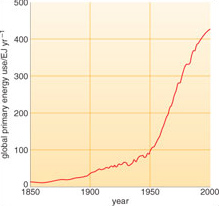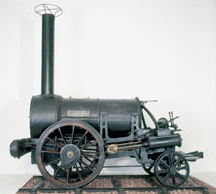1 Energy use
Until about 8000 years ago humans relied on hunting and gathering for food, and burning wood to keep warm. Their exact energy demands can at best only be estimated but to survive they probably needed about as much energy as it takes to run a couple of ordinary domestic light bulbs continuously. Later, agriculture developed, and although wood was still the chief fuel, animal power, animal dung and charcoal were also used. Even today, such energy sources based on natural biomass dominate the lives of human populations in the so-called 'Third World' or 'developing countries'. The 19th century heralded a large increase in energy use in what were to become industrialised countries (Figure 1.1), particularly the use of coal. Homes and other buildings were heated; factories and railways were powered by steam engines (Figure 1.2); mining and chemical industries developed and agriculture became more mechanised. The emergence of technological societies in the 20th century resulted in an even larger increase in energy use for manufacturing, agriculture, transport and a host of other applications. In technologically advanced countries the largest increases have been in using gas for heating, oil products for transport, and electricity as a convenient means of transferring energy generated by a variety of sources (Figure 1.3).



It is important to remember that the primary energy released by all forms of energy resources is not the amount that performs useful tasks: it is the total amount of energy released by human activity. Energy use and conversion, as you will see, can never be fully efficient. For that reason, the energy consumed usefully by society is considerably less than primary energy released: you will find that we refer to both primary energy and energy consumption (sometimes demand), depending on the context.
World population rose from some 5 million 10 000 years ago, through 1 billion in the 19th century to 6.5 billion in 2005. This rapid increase in population, together with a sharp increase in the demand that each person in the developed world has for energy, led to the dramatic rise in global energy consumption (Figure 1.1).
All the Earth's physical resources, for example metals in ores, water supplies and building stone, depend on using energy to extract, process and transport them. In effect, the ability to extract and use the Earth's physical resources depends on whether there is a ready supply of energy at the right price. If there were a limitless supply of cheap energy we could turn the entire stock of all physical resources into reserves. One aim of this book, and indeed the whole course, is to examine the limits that exist in reality: some are governed by physical laws, others depend on economics and there are also limits posed by sustaining the Earth's environmental conditions on which life depends.
